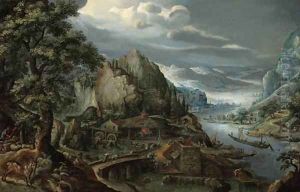Marten Van Valkenborch I Paintings
Marten van Valkenborch I was a Flemish painter born in 1535 in Leuven, located in the Duchy of Brabant, now part of modern-day Belgium. He was part of the prominent Valkenborch family, which included several notable artists who made significant contributions to the Northern Renaissance art movement. Marten's work is often characterized by its intricate landscape and cityscape compositions, reflecting the burgeoning interest in naturalism and detailed scenery among artists of the period.
Van Valkenborch's early life was marked by the turbulent religious and political climate of the Low Countries during the 16th century. This environment, coupled with the influence of the Renaissance sweeping through Europe, played a crucial role in shaping his artistic direction. He likely received his initial training within his family, which was common practice at the time. By the 1560s, his talent and reputation as a landscape artist began to emerge, leading to the development of his distinctive style.
In 1586, due to the Spanish Inquisition and the increasing unrest in the Spanish Netherlands, Marten van Valkenborch, like many artists of his time, chose to relocate for safety and better opportunities. He moved to Germany, where he spent much of his career, particularly in Frankfurt am Main. This period was marked by significant artistic growth and experimentation. In Germany, he became known for his detailed panoramic views and allegorical landscapes, often incorporating elements of the seasons, the elements, or biblical and mythological themes, showcasing his versatility and imagination.
Marten's works were highly sought after, and his influence extended beyond his immediate circle. He taught and worked alongside his brother Lucas and his sons Frederik and Gillis, who also became accomplished artists. His legacy is visible in the continuation of the landscape genre and the detailed, narrative-rich approach to painting that would influence future generations of artists.
Marten van Valkenborch I passed away in 1612 in Frankfurt am Main. His art remains a testament to the Northern Renaissance's fascination with the natural world and the intricate relationship between humanity and its environment. Today, his works are preserved in various museums and collections worldwide, where they continue to be studied and admired for their historical significance and artistic beauty.
